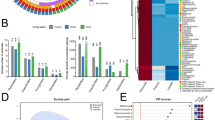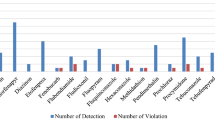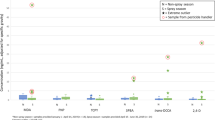Abstract
We developed a pesticide residue burden score (PRBS) based on a food frequency questionnaire and surveillance data on food pesticide residues to characterize dietary exposure over the past year. In the present study, we evaluated the association of the PRBS with urinary concentrations of pesticide biomarkers. Fruit and vegetable (FV) intake was classified as having high (PRBS≥4) or low (PRBS<4) pesticide residues for 90 men from the EARTH study. Two urine samples per man were analyzed for seven biomarkers of organophosphate and pyrethroid insecticides, and the herbicide 2,4-dichlorophenoxyacetic acid. We used generalized estimating equations to analyze the association of the PRBS with urinary concentrations of pesticide biomarkers. Urinary concentrations of pesticide biomarkers were positively related to high pesticide FV intake but inversely related to low pesticide FV intake. The molar sum of urinary concentrations of pesticide biomarkers was 21% (95% confidence interval (CI): 2%, 44%) higher for each one serving/day increase in high pesticide FV intake, and 10% (95% CI: 1%, 18%) lower for each one serving/day increase in low pesticide FV intake. Furthermore, intake of high pesticide FVs positively related to most individual urinary biomarkers. Our findings support the usefulness of the PRBS approach to characterize dietary exposure to select pesticides.
This is a preview of subscription content, access via your institution
Access options
Subscribe to this journal
Receive 6 print issues and online access
$259.00 per year
only $43.17 per issue
Buy this article
- Purchase on Springer Link
- Instant access to full article PDF
Prices may be subject to local taxes which are calculated during checkout


Similar content being viewed by others
References
Centers for Disease Control and Prevention Fourth National Report on Human Exposure to Environmental Chemicals, Updated Tables, February 2015. Available at http://www.cdc.gov/exposurereport. Atlanta, GA, USA: Department of Health and Human Services, Centers for Disease Control and Prevention 2015.
US Food and Drug Administration Pesticide monitoring program fiscal year 2012 pesticide report 2012.
Fortes C, Mastroeni S, Pilla MA, Antonelli G, Lunghini L, Aprea C . The relation between dietary habits and urinary levels of 3-phenoxybenzoic acid, a pyrethroid metabolite. Food Chem Toxicol 2013; 52: 91–96.
Lu C, Toepel K, Irish R, Fenske RA, Barr DB, Bravo R . Organic diets significantly lower children's dietary exposure to organophosphorus pesticides. Environ Health Perspect 2006; 114: 260–263.
Bradman A, Quiros-Alcala L, Castorina R, Schall RA, Camacho J, Holland NT et al. Effect of organic diet intervention on pesticide exposures in young children living in low-income urban and agricultural communities. Environ Health Perspect 2015; 123: 1086–1093.
Oates L, Cohen M, Braun L, Schembri A, Taskova R . Reduction in urinary organophosphate pesticide metabolites in adults after a week-long organic diet. Environ Res 2014; 132: 105–111.
Wielgomas B . Variability of urinary excretion of pyrethroid metabolites in seven persons over seven consecutive days—implications for observational studies. Toxicol Lett 2013; 221: 15–22.
Bradman A, Kogut K, Eisen EA, Jewell NP, Quiros-Alcala L, Castorina R et al. Variability of organophosphorous pesticide metabolite levels in spot and 24-hr urine samples collected from young children during 1 week. Environ Health Perspect 2013; 121: 118–124.
Sudakin DL, Stone DL . Dialkyl phosphates as biomarkers of organophosphates: the current divide between epidemiology and clinical toxicology. Clin Toxicol 2011; 49: 771–781.
Spaan S, Pronk A, Koch HM, Jusko TA, Jaddoe VW, Shaw PA et al. Reliability of concentrations of organophosphate pesticide metabolites in serial urine specimens from pregnancy in the Generation R Study. J Expo Sci Environ Epidemiol 2015; 25: 286–294.
Morgan MK, Sheldon LS, Croghan CW, Jones PA, Robertson GL, Chuang JC et al. Exposures of preschool children to chlorpyrifos and its degradation product 3,5,6-trichloro-2-pyridinol in their everyday environments. J Expo Anal Environ Epidemiol 2005; 15: 297–309.
Krieger RI, Dinoff TM . Malathion deposition, metabolite clearance, and cholinesterase status of date dusters and harvesters in California. Arch Environ Contam Toxicol 2000; 38: 546–553.
Chiu YH, Afeiche MC, Gaskins AJ, Williams PL, Petrozza JC, Tanrikut C et al. Fruit and vegetable intake and their pesticide residues in relation to semen quality among men from a fertility clinic. Hum Reprod 2015; 30: 1342–1351.
Chiu YH, Gaskins AJ, Williams PL, Mendiola J, Jorgensen N, Levine H et al. Intake of fruits and vegetables with low-to-moderate pesticide residues is positively associated with semen-quality parameters among young healthy men. J Nutr 2016; 146: 1084–1092.
Hu Y, Chiu Y-H, Hauser R, Chavarro J, Sun Q . Overall and class-specific scores of pesticide residues from fruits and vegetables as a tool to rank intake of pesticide residues in United States: a validation study. Environ Int 2016; 92: 294–300.
ATSDR Toxicological Profile for Pyrethrins and Pyrethroids. Atlanta, GA:Agency for Toxic Substances and Disease Registry 2003.
Environmental Protection Agency 2,4-D. Available at https://www.epa.gov/ingredients-used-pesticide-products/24-d. accessed 8 June 2016 2016.
Wolf AM, Hunter DJ, Colditz GA, Manson JE, Stampfer MJ, Corsano KA et al. Reproducibility and validity of a self-administered physical activity questionnaire. Int J Epidemiol 1994; 23: 991–999.
CDC Fourth National Report on Human Exposure to Environmental Chemicals. Centers for Disease Control and Prevention: Washington, DC. 2009.
Rimm EB, Giovannucci EL, Stampfer MJ, Colditz GA, Litin LB, Willett WC . Reproducibility and validity of an expanded self-administered semiquantitative food frequency questionnaire among male health professionals. Am J Epidemiol 1992; 135: 1114–1126.
Feskanich D, Rimm EB, Giovannucci EL, Colditz GA, Stampfer MJ, Litin LB et al. Reproducibility and validity of food intake measurements from a semiquantitative food frequency questionnaire. J Am Diet Assoc 1993; 93: 790–796.
USDA Pesticide Data Program (PDP), annual sumary. URL http://www.ams.usda.gov/AMSv1.0/PDP. USDA, Agricultural Marketing Service 2006-2015.
Davis MD, Wade EL, Restrepo PR, Roman-Esteva W, Bravo R, Kuklenyik P et al. Semi-automated solid phase extraction method for the mass spectrometric quantification of 12 specific metabolites of organophosphorus pesticides, synthetic pyrethroids, and select herbicides in human urine. J Chromatogr B 2013; 929: 18–26.
Smith KW, Braun JM, Williams PL, Ehrlich S, Correia KF, Calafat AM et al. Predictors and variability of urinary paraben concentrations in men and women, including before and during pregnancy. Environ Health Perspect 2012; 120: 1538–1543.
Hornung R, Reed L . Estimation of average concentration in the presence of nondetectable values. Appl Occup Environ Hyg 1990; 5: 46–51.
Pastore LM, Hertz-Picciotto I, Beaumont JJ . Risk of stillbirth from occupational and residential exposures. Occup Environ Med 1997; 54: 511–518.
Starr J, Graham S, Stout D, 2nd, Andrews K, Nishioka M . Pyrethroid pesticides and their metabolites in vacuum cleaner dust collected from homes and day-care centers. Environ Res 2008; 108: 271–279.
Willett W . Nutritional epidemiology: issues and challenges. Int J Epidemiol 1987; 16: 312–317.
Searle SR, Speed FM, Milliken GA . Population marginal means in the linear model: an alternative to least squares means. Am Stat 1980; 34: 216–221.
Rosner B, Glynn RJ . Interval estimation for rank correlation coefficients based on the probit transformation with extension to measurement error correction of correlated ranked data. Stat Med 2007; 26: 633–646.
Harley KG, Engel SM, Vedar MG, Eskenazi B, Whyatt RM, Lanphear BP et al. Prenatal exposure to organophosphorous pesticides and fetal growth: pooled results from four longitudinal birth cohort studies. Environ Health Perspect 2016; 124: 1084–1092.
Lu C, Barr DB, Pearson MA, Walker LA, Bravo R . The attribution of urban and suburban children's exposure to synthetic pyrethroid insecticides: a longitudinal assessment. J Expo Sci Environ Epidemiol 2009; 19: 69–78.
Marks AR, Harley K, Bradman A, Kogut K, Barr DB, Johnson C et al. Organophosphate pesticide exposure and attention in young Mexican-American children: the CHAMACOS study. Environ Health Perspect 2010; 118: 1768–1774.
Centers for Disease Control and Prevention Fourth National Report on Human Exposure to Environmental Chemicals. Department of Health and Human Services, Centers for Disease Control and Prevention: Atlanta, GA, USA. 2009.
Environmental Protection Agency. Proposal to Revoke Chlorpyrifos Food Residue Tolerances. Available at https://www.epa.gov/ingredients-used-pesticide-products/proposal-revoke-chlorpyrifos-food-residue-tolerances. Accessed 8 July 2016. 2016.
Ratelle M, Cote J, Bouchard M . Toxicokinetics of permethrin biomarkers of exposure in orally exposed volunteers. Toxicol Lett 2015; 232: 369–375.
Nolan RJ, Rick DL, Freshour NL, Saunders JH . Chlorpyrifos: pharmacokinetics in human volunteers. Toxicol Appl Pharmacol 1984; 73: 8–15.
Natural Marketing Institue Consumer insights on organic and natural. Organic&Natural Health Associationv, 2015.
Curl CL, Beresford SA, Fenske RA, Fitzpatrick AL, Lu C, Nettleton JA et al. Estimating pesticide exposure from dietary intake and organic food choices: the Multi-Ethnic Study of Atherosclerosis (MESA). Environ Health Perspect 2015; 123: 475–483.
Garfitt SJ, Jones K, Mason HJ, Cocker J . Exposure to the organophosphate diazinon: data from a human volunteer study with oral and dermal doses. Toxicol Lett 2002; 134: 105–113.
Woollen BH, Marsh JR, Laird WJ, Lesser JE . The metabolism of cypermethrin in man: differences in urinary metabolite profiles following oral and dermal administration. Xenobiotica 1992; 22: 983–991.
Poet TS, Timchalk C, Hotchkiss JA, Bartels MJ . Chlorpyrifos PBPK/PD model for multiple routes of exposure. Xenobiotica 2014; 44: 868–881.
Moore LV, Dodd KW, Thompson FE, Grimm KA, Kim SA, Scanlon KS . Using behavioral risk factor surveillance system data to estimate the percentage of the population meeting US department of agriculture food patterns fruit and vegetable intake recommendations. Am J Epidemiol 2015; 181: 979–988.
Acknowledgements
The authors gratefully acknowledge Mark Davis and William Roman (CDC, Atlanta, GA) for their technical assistance with pesticide biomarkers measurements. We also acknowledge all members of the EARTH study team, specifically the Harvard T. H. Chan School of Public Health research staff Jennifer Ford, Myra Keller, and Ramace Dadd, physicians and staff at Massachusetts General Hospital fertility center. A special thank you to all of the study participants. Yu-Han Chiu gratefully acknowledges the doctoral scholarship from the Irene M. and Fredrick J. Stare Nutrition Education Fund. This research was funded by NIH grants R01ES022955, R01ES009718 and P01ES000002 from NIEHS and P30DK046200 from NIDDK; Harvard National Institute of Environmental Health Sciences (NIEHS) Center for Environmental Health Pilot Project Program. Qi Sun was supported by NIH grants ES021372 and ES022981. The findings and conclusions in this report are those of the authors and do not necessarily represent the official position of the Centers for Disease Control and Prevention or the National Institutes of Health.
Author information
Authors and Affiliations
Consortia
Corresponding author
Ethics declarations
Competing interests
The authors declare no conflict of interest.
Additional information
Supplementary Information accompanies the paper on the Journal of Exposure Science and Environmental Epidemiology website
Supplementary information
Rights and permissions
About this article
Cite this article
Chiu, YH., Williams, P., Mínguez-Alarcón, L. et al. Comparison of questionnaire-based estimation of pesticide residue intake from fruits and vegetables with urinary concentrations of pesticide biomarkers. J Expo Sci Environ Epidemiol 28, 31–39 (2018). https://doi.org/10.1038/jes.2017.22
Received:
Accepted:
Published:
Issue Date:
DOI: https://doi.org/10.1038/jes.2017.22
Keywords
This article is cited by
-
Dietary pesticide exposure and non-communicable diseases and mortality: a systematic review of prospective studies among adults
Environmental Health (2023)
-
Measurement of urinary pesticide biomarkers among Latina farmworkers in southwestern Idaho
Journal of Exposure Science & Environmental Epidemiology (2021)
-
Application of the Food Quality Protection Act children’s health safety factor in the U.S. EPA pesticide risk assessments
Environmental Health (2020)
-
The Role of Lifestyle in Male Infertility: Diet, Physical Activity, and Body Habitus
Current Urology Reports (2018)
-
Pestizidrückstände in Gemüse und Obst und Outcome bei Frauen unter ART
Gynäkologische Endokrinologie (2018)



